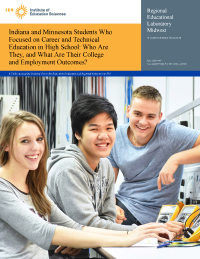-
About the RELs
+
-
For more than 50 years, the RELs have collaborated with school districts, state departments of education, and other education stakeholders to help them generate and use evidence and improve student outcomes. Read more
-
- Regions +
- Products
-
Topics
+
- Achievement Gap Career Readiness Charter Schools College Readiness COVID-19 Data Use Discipline Dropout Prevention
- Early Childhood Education English Language Learners Equity Literacy Mathematics Online Courses Postsecondary Education Principals
- Research Tools Rural Schools Social Emotional Learning Special Education Student Characteristics Teacher Effectiveness Teacher Persistence Teacher Recruitment
- Events
- Blog
- Connect with Us +
Home Publications Indiana and Minnesota Students Who Focused on Career and Technical Education in High School: Who Are They, and What Are Their College and Employment Outcomes?
Indiana and Minnesota Students Who Focused on Career and Technical Education in High School: Who Are They, and What Are Their College and Employment Outcomes?

In Indiana and Minnesota the state education agency, state higher education agency, and the state workforce agency have collaborated to develop career and technical education courses intended to improve high school students' college and career readiness. These agencies partnered with the Regional Educational Laboratory Midwest to examine whether high school graduates in each state who completed a large number of career and technical education courses in a single career-oriented program of study (concentrators) had different college and workforce outcomes from graduates who completed fewer (samplers) or no career and technical education courses (nonparticipants). The study found that in the 2012/13-2017/18 graduation cohorts, male graduates were more likely to be concentrators than female graduates, and graduates who received special education services were more likely to be concentrators than those who did not receive services. Graduates who were not proficient in reading in grade 8 also were more likely to become concentrators than those who were proficient. Graduates who attended urban and suburban schools were more likely than students who attended town and rural schools to be nonparticipants. Concentrators were less likely than samplers and nonparticipants with similar characteristics to enroll in college, but the differences reflect mainly enrollment in four-year colleges. Concentrators were more likely to enroll in two-year colleges. Concentrators also were less likely than similar samplers and nonparticipants to complete a bachelor's degree within four to six years. Finally, compared with similar samplers and nonparticipants, concentrators were employed at higher rates in the first five years after high school and had higher earnings. [For the study brief, see ED613045; for the study snapshot, see ED613046; and for the appendixes, see ED613050.]
Online Availability
ERIC Descriptors
Academic Degrees, Access to Education, Career Development, Career Readiness, College Attendance, College Readiness, Course Selection (Students), Education Work Relationship, Educational Attainment, Educational Certificates, Employment Level, English Language Learners, Enrollment, Equal Education, Ethnicity, Gender Differences, High School Graduates, High School Students, Institutional Characteristics, Occupations, Outcomes of Education, Program Effectiveness, Public Schools, Racial Differences, Reading Skills, Rural Schools, School Size, Special Education, Student Characteristics, Suburban Schools, Two Year Colleges, Urban Schools, Vocational Education, Wages, EquityPublication Information
Midwest | Publication Type:
Impact Study | Publication
Date: June 2021
Related Products
Increasing the Reach of Career and Technical Education (CTE)
Connect with REL Midwest